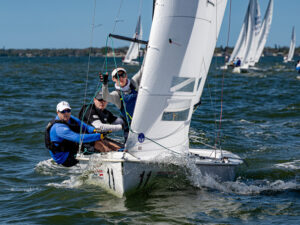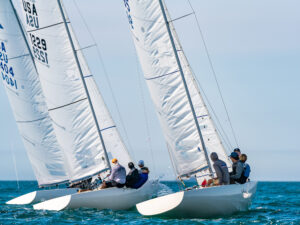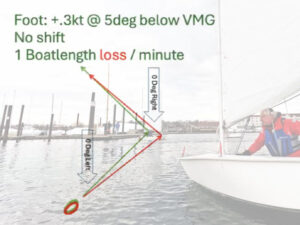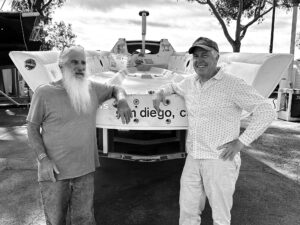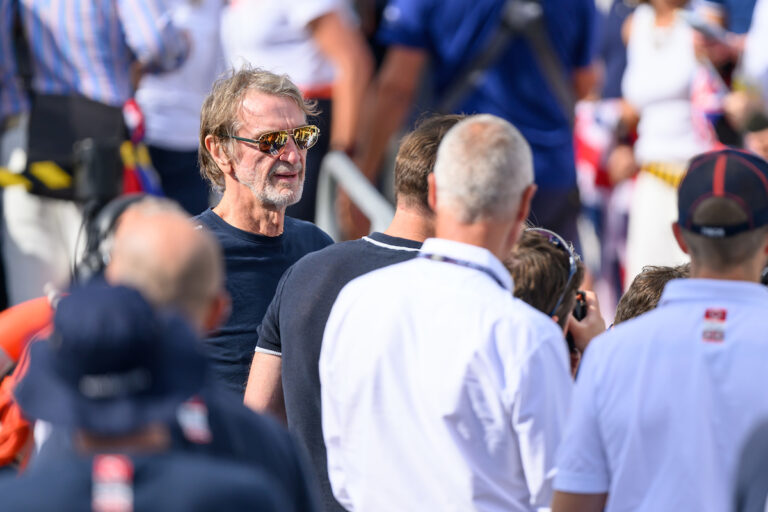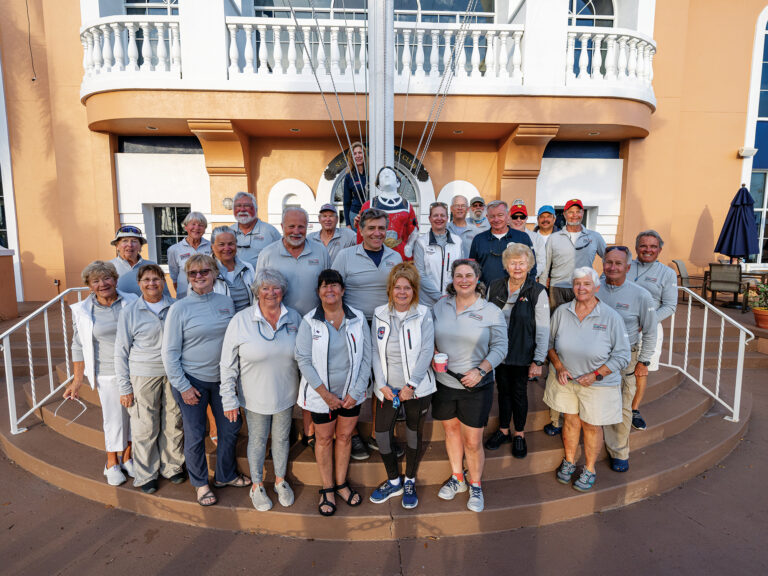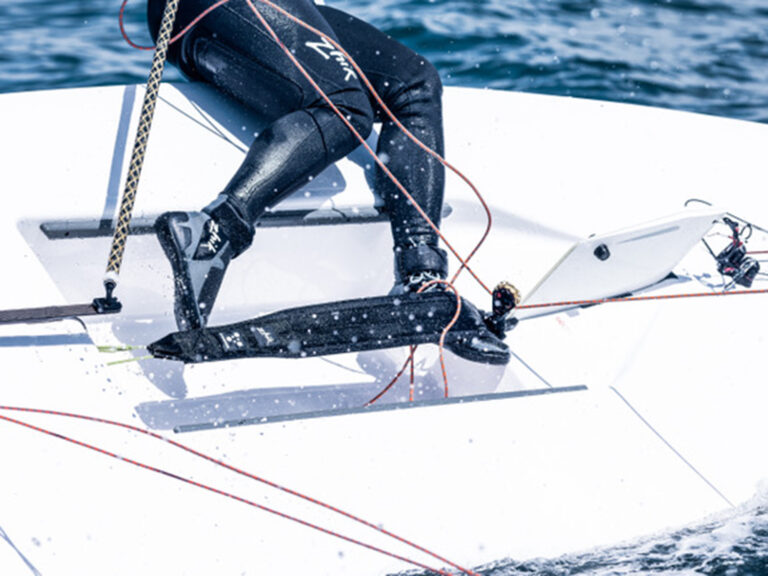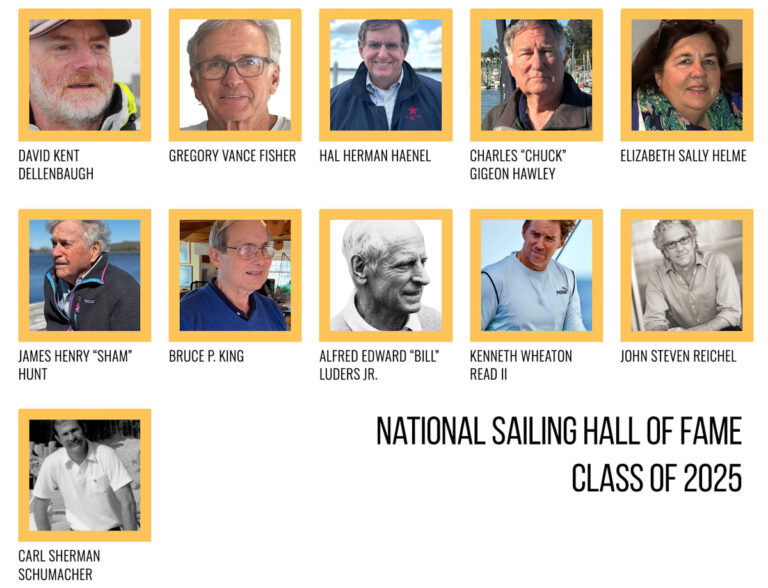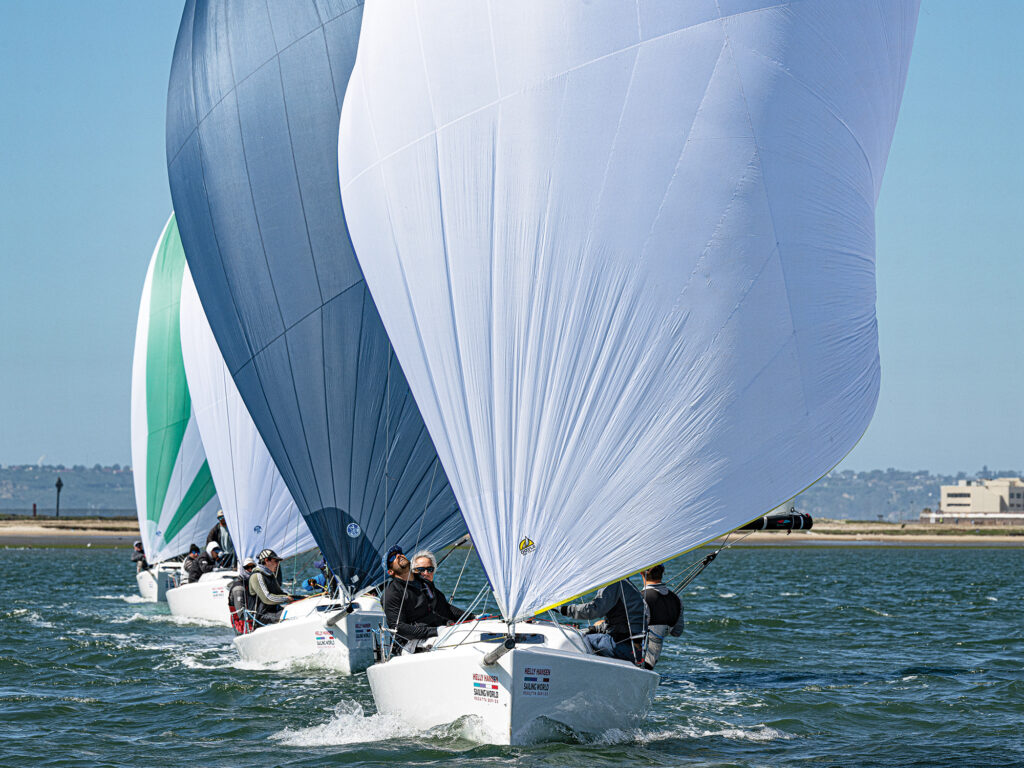
As a sailor who floats among many different classes, I tend to seek out transferable performance patterns. More valuable to me than the ability to memorize a tuning matrix is the understanding of how to interpret the location and prominence of overbend wrinkles in a mainsail, the amount of tension or dangle in the leeward shrouds, or the frequency of stall or flow over the leech telltales. Utilizing the sail plan’s power and balance cues that will present themselves on any boat is the key to reducing the learning curve in a new fleet and outperforming the tuning guide in an established class.
Once we turn downwind, however, the underlying indicators of net VMG gains are trickier to recognize and isolate, especially in sportboats with asymmetric spinnakers where we are trying to decide when exactly the transitions occur between the fully planing, lazy planing, low displacement, or occasional wing-on-wing modes. So how do we get down the course successfully in the absence of a mode-crossover bible? Rig tune and sail trim are substantially less nuanced downwind than they are upwind, so a balance of sheet load, helm load, boatspeed, and heel angle can hold the answer.
Feel Your Sheet Load
The most basic goal of asymmetric-spinnaker trim is to ease the sheet enough to maximize projection to windward of the main, without sacrificing too much pressure in the sheet. A good visual indication that we are achieving maximum projection is a small amount of curl flicking into the luff every few seconds. This does not, however, indicate that we have adequate power in the sail, which is why the trimmer’s job of communicating the sheet load is critical.
If the sheet load is notably soft, then our angle is too low and we need to transition to a faster mode. The turn up should be induced by shifting crew weight to leeward and forward while trimming the main accordingly. The biggest risk here is sailing extra distance for negligible speed gains in a dying breeze. Be sure that the conversation includes information about the big-picture breeze on the course as well as localized puffs and lulls so that the trimmer can recalibrate their target sheet load periodically.
On the other hand, if the sheet load is consistently heavy, even with accurate luff curl, then our angle is too high and we must shift the crew weight to windward and aft, ease the sails out, and/or use the rudder to turn the boat down. A moderately loaded sheet and happily curling luff are good indications that we are starting to home in on the correct mode. If the turn down is not enough to alleviate the excess sheet load, then we know that it’s time to unfurl the jib, transition to a lazy plane or full plane mode, and start focusing more on helm load.
Balance the Helm Load
In light air, when the helm load is quite light, the goal is to avoid leading any turns with the rudder because it will be slow and draggy. Once the conditions have us fully powered or overpowered, the rudder becomes quite important, and awareness of helm load will help keep us in control. While deploying the jib will add sail area and increase boatspeed, the more important feature becomes its ability to balance out some of the helm load. As the breeze and boatspeed continue to trend up and waves start to come over the bow, crew weight must shift aft to keep the rudder deep in the water and maintain grip through turns. Too much helm load or too sharp of a turn could cause the rudder to cavitate and the boat to wipe out. A heavily loaded helm will require eased sails to free up enough to turn down smoothly. As the driver and trimmer are able to calibrate and coordinate loads in the helm and sheet, the boat will gravitate toward its proper mode.
Strive for Consistent Boatspeed
In the simplest terms, the proper mode is indicated by a barely sustainable boatspeed. If speed is too easy to maintain, you are sailing too high. If speed drops off quickly or continuously, you are sailing too low. The goal is to sail as close as possible to the “cliff” without falling. Catching speed dips early and settling back into the groove quickly will minimize VMG losses, whereas letting the boat truly decelerate will cause a big swing aft in the apparent wind and force an exaggerated turn up to build speed again. Once the trimmer is reporting good sheet load, the driver has a manageable helm load, and boatspeed is consistent, then a stable heel angle is the last indication that our mode is correct.
Lock In Heel Angle
In underpowered conditions, some leeward heel is good. As the power decreases in the main first, the spinnaker will lure the boat down, but the leeward heel will counteract it without having to induce drag via rudder angle. As the breeze comes up slightly and spotty puffs come through the course, we can utilize heel angle to force the bow down in the puffs and up in the lulls, while maintaining consistent boatspeed is still the primary focus.
In fully powered and overpowered conditions, we shift the target to maintaining as flat a boat as possible. In order to achieve this, the team should settle into hiking positions that are sustainable for an entire downwind leg. Stable crew weight and heel angle will allow the trimmer and driver to really lock in on the correct mode. Quick turns with the tiller down to drive off excess heel and up to reload the windward rail are rewarded in the fully planing mode.
The major exception to constant boatspeed and heel angle is in the presence of a surfable sea state. When the waves are generally perpendicular to our angle, we can pump the sheets to induce the surf, then hike and drive the boat down as we accelerate. This is an active mode and requires accurate driving to maintain the surf for as long as possible without crashing the bow into the wave in front. The decrease in speed and rebuild after coming off a wave should be short and efficient to maintain net gains. When the waves are more broadside, they will tend to roll the boat. Aggressively squashing crew weight to windward to counteract the leeward heel and to back to leeward to counteract the windward heel can prevent the helm from sharply loading and unloading while helping the boat surge down the course.
Learning to find the proper boatspeed and heel-angle grooves while balancing the appropriate sheet and helm loads is a crucial step in finding optimal downwind sportboat modes. They provide the necessary road map to locating mode crossovers from one boat to the next, one team to the next, one venue to the next, and one condition to the next.

